
The L. D. M. Sweat Memorial Galleries are a series of art galleries that are part of the Portland Museum of Art, which is located in the Arts District of Portland, Maine.

The L. D. M. Sweat Memorial Galleries are a series of art galleries that are part of the Portland Museum of Art, which is located in the Arts District of Portland, Maine.
The L. D. M. Sweat Memorial Galleries were built in 1911 by Maine architect John Calvin Stevens. They were named to honor Lorenzo De Medici Sweat, the husband of Portland Museum of Art benefactor, Margaret Jane Mussey Sweat (1823–1908). The building was designed to complement the Federal style architecture of the McLellan House, the oldest building of the museum complex. [1] The McLellan House and Sweat Galleries were closed in 1980 for the construction of the Payson Building. They remained closed until October 5, 2002, after a two-year restoration. [2]
The primary focus is on 19th- and 20th-century American art — sculpture, furniture, decorative arts and paintings, with specific emphasis on a large collection of works by Winslow Homer. As stated by the museum's board, the works of art in the galleries are an attempt to:
... reflect the changing customs, tastes, and concerns of Americans who created, purchased, and commissioned them. In these galleries, you will travel back through the history of art in the United States. The journey begins with works created on the eve of the 20th century that look back to the United States' rich history and forward to the challenges of a new era. These give way to the lush portraits, still lifes, and exotic scenes that represent the height of academic painting in America and the tastes of a cultivated and wealthy leisure class. [3]

The galleries feature many 19th- and 20th-century American artists, including:
In 2001, there was an open house at the galleries, where modern artists created works to enhance the gallery collection and yet fit in with the existing art and decor. Artists involved in the project included Jonathan Bailey, Paul D'Amato, Tonee Harbert, Rose Marasco, Tanja Alexia Hollander and Bernard C. Meyers. The first exhibition was new work by Sa Schloff. [4]
The galleries have been featured in the Portland Journal of Antiquities, as well. [5]
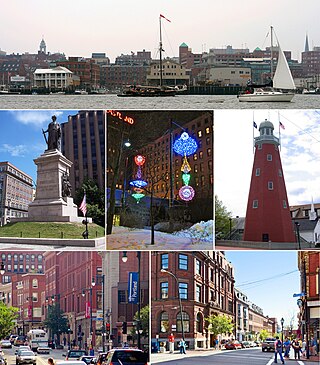
Portland is a city in the U.S. state of Maine. It is the most populous city in the state and the seat of Cumberland County. Portland's population was 68,408 in April 2020. The Greater Portland metropolitan area has a population of approximately 550,000 people. Historically tied to commercial shipping, the marine economy, and light industry, Portland's economy in the 21st century relies mostly on the service sector. The Port of Portland is the second-largest tonnage seaport in the New England area as of 2019.

Winslow Homer was an American landscape painter and illustrator, best known for his marine subjects. He is considered one of the foremost painters of 19th-century America and a preeminent figure in American art in general.

The Portland Art Museum (PAM) is an art museum in downtown Portland, Oregon, United States. The Portland Art Museum has 240,000 square feet, with more than 112,000 square feet of gallery space. The museum’s permanent collection has over 42,000 works of art. PAM features a center for Native American art, a center for Northwest art, a center for modern and contemporary art, permanent exhibitions of Asian art, and an outdoor public sculpture garden. The Northwest Film Center is also a component of Portland Art Museum.

Joan Whitney Payson was an American heiress, businesswoman, philanthropist, patron of the arts and art collector, and a member of the prominent Whitney family. She was also co-founder and majority owner of Major League Baseball's New York Mets baseball franchise, and was the first woman to own a major league team in North America without inheriting it.

The Portland Museum of Art, or PMA, is the largest and oldest public art institution in the U.S. state of Maine. Founded as the Portland Society of Art in 1882. It is located in the downtown area known as The Arts District in Portland, Maine.
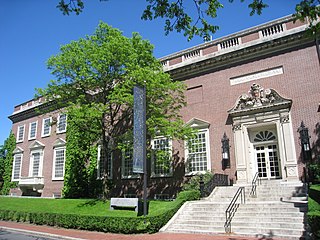
The Harvard Art Museums are part of Harvard University and comprise three museums: the Fogg Museum, the Busch-Reisinger Museum, and the Arthur M. Sackler Museum, and four research centers: the Archaeological Exploration of Sardis, the Center for the Technical Study of Modern Art, the Harvard Art Museums Archives, and the Straus Center for Conservation and Technical Studies. The three museums that constitute the Harvard Art Museums were initially integrated into a single institution under the name Harvard University Art Museums in 1983. The word "University" was dropped from the institutional name in 2008.
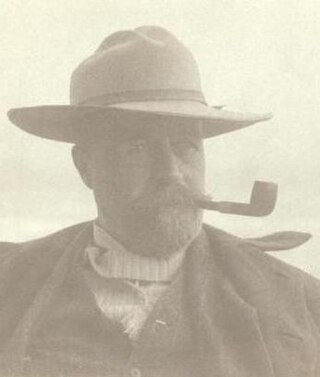
John Calvin Stevens was an American architect who worked in the Shingle Style, in which he was a major innovator, and the Colonial Revival style. He designed more than 1,000 buildings in the state of Maine.
A limner is an illuminator of manuscripts, or more generally, a painter of ornamental decoration. One of the earliest mentions of a limner's work is found in the book Methods and Materials of Painting by Charles Lock Eastlake (1793–1865).
"The treatises [on oil painting] cannot be placed later than the thirteenth, or beginning of the fourteenth, century. This was the age of Dante, and "the art which in Paris was called illuminating" (limning) is well illustrated by such guides." p. 45

Memphis Brooks Museum of Art is an art museum in Memphis, Tennessee. The Brooks Museum, which was founded in 1916, is the oldest and largest art museum in the state of Tennessee. The museum is a privately funded nonprofit institution located in Overton Park in Midtown Memphis.

The McLellan-Sweat Mansion is a historic house museum on High Street in Portland, Maine. It forms the rear component of the Portland Museum of Art complex. Built in 1800–01, the house was designated a National Historic Landmark in 1970 as a well-preserved Federal style brick townhouse.

The Charles Shipman Payson Building is the most recent expansion of the Portland Museum of Art (PMA) in Portland, Maine, located on the corner of High Street and Congress Square. Henry N. Cobb designed the Payson Building, which introduced over five times more gallery space than in the adjacent, historic PMA buildings. The building opened in 1983, after Mr. Payson donated 17 Winslow Homer paintings and ten million dollars to the museum. Similar in theme to these Homer paintings, the Payson building contains a collection of contemporary paintings and short-term exhibitions created by Maine artists, focusing on regional themes.
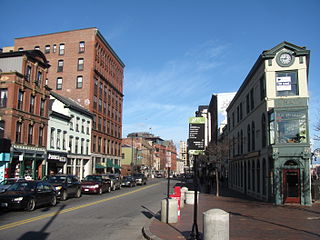
The Arts District is a section of downtown Portland, Maine’s designated in 1995 as to promote the cultural community and creative economy of the city. It covers a large part of upper Congress Street towards the West End and spans Congress Street toward the East ending at Portland City Hall and its Merrill Auditorium concert hall.

The Georgia Museum of Art is an art museum in Athens, Georgia, United States, associated with the University of Georgia (UGA). The museum is both an academic museum and, since 1982, the official art museum of the state of Georgia. The permanent collection consists of American paintings, primarily 19th- and 20th-century; American, European and Asian works on paper; the Samuel H. Kress Study Collection of Italian Renaissance paintings; growing collections of southern decorative arts and Asian art; and a strong collection of works by African American artists. It numbers more than 17,000 works, growing every year.
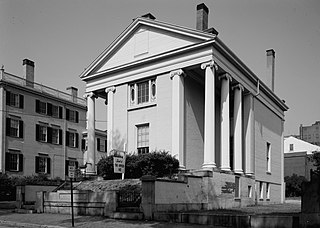
The Charles Q. Clapp House is a historic house at 97 Spring Street in central Portland, Maine. Built in 1832, it is one of Maine's important early examples of high style Greek Revival architecture. Probably designed by its first owner, Charles Q. Clapp, it served for much of the 20th century as the home of the Portland School of Fine and Applied Art, now the Maine College of Art. It is now owned by the adjacent Portland Museum of Art. It was listed on the National Register of Historic Places in 1972.
Zillman Art Museum-University of Maine (ZAM) is an art museum in downtown Bangor, Maine. It is part of the University of Maine, which is located in nearby Orono, Maine. The University of Maine Art Collection was established in 1946, under the leadership of Vincent Hartgen. As the initial faculty member of the Department of Art and curator of the art collection, Hartgen's goal was to provide the people of Maine with significant opportunities to experience and learn about the visual arts and their diverse histories and cultural meanings.
The following is a timeline of the history of the city of Portland, Maine, USA.

Charles Frederick Kimball (1831–1903) was a 19th-century American painter who focused on pastoral landscapes and marine art. He was also an etcher and a master cabinet maker. He was active in Portland, Maine.
Gertrude Tiemer Wille was an American painter, photographer, and poet. Tiemer achieved her greatest notoriety for inter-dimensional, multi-exposure photography. Her paintings of landscapes, still lifes, portraits, and other pieces adopted both the realist and abstract styles of art. Tiemer exhibited her work at galleries in Maine, New York City, and other venues throughout the U.S. and internationally.
Jessica F. Nicoll is an American museum director and curator and an authority on American art and culture. She serves as Director and Louise Ines Doyle '34 Chief Curator of the Smith College Museum of Art. She was previously the Chief Curator and Curator of American Art of the Portland Museum of Art.
Aaron T Stephan is an American artist based in Portland, Maine. His work includes sculpture, mixed media, performance, and installation art has been featured at a number of exhibitions, collections, and festivals.